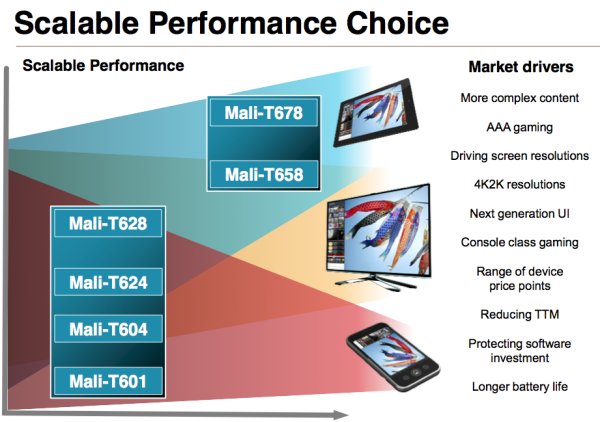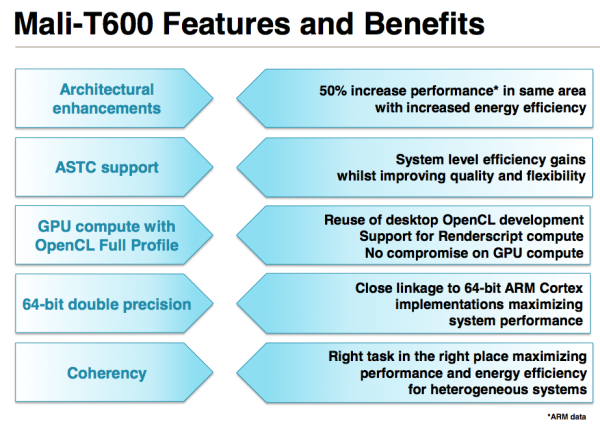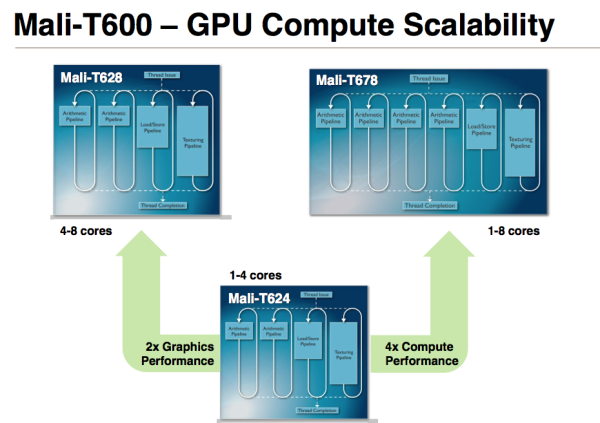ARM Announces 8-core 2nd Gen Mali-T600 GPUs
by Anand Lal Shimpi on August 6, 2012 11:49 AM ESTIn our discrete GPU reviews for the desktop we've often noticed the tradeoff between graphics and compute performance in GPU architectures. Generally speaking, when a GPU is designed for compute it tends to sacrifice graphics performance or vice versa. You can pursue both at the same time, but within a given die size the goals of good graphics and compute performance are usually at odds with one another.
Mobile GPUs aren't immune to making this tradeoff. As mobile devices become the computing platform of choice for many, the same difficult decisions about balancing GPU compute and graphics performance must be made.
ARM announced its strategy to dealing with the graphics/compute split earlier this year. In short, create two separate GPU lines: one in pursuit of great graphics performance, and one optimized for graphics and compute.
Today all of ARM's shipping GPUs fall on the blue, graphics trend line in the image above. The Mali-400 is the well known example, but the forthcoming Mali-450 (8-core Mali-400 with slight improvements to IPC) is also a graphics focused part.
The next-generation ARM GPU architecture, codenamed Midgard but productized as the Mali-T600 series will have members optimized for graphics performance as well as high-end graphics/GPU compute performance.
The split looks like this:
The Mali-T600 series is ARM's first unified shader architecture. The parts on the left fall under the graphics roadmap, while the parts on the right are optimized for graphics and GPU compute. To make things even more confusing, the top part in each is actually a second generation T600 GPU, announced today.
What does the second generation of T600 give you? Higher IPC and higher clock speeds in the same die area thanks to some reworking of the architecture and support for ASTC (an optional OpenGL ES texture compression spec we talked about earlier today).
Both the T628 and T678 are eight-core parts, the primary difference between the two (and between graphics/GPU compute optimized ARM GPUs in general) is the composition of each shader core. The T628 features two ALUs, a LSU and texture unit per shader, while the T658 doubles up the ALUs per core.
Long term you can expect high end smartphones to integrate cores from the graphics & compute optimized roadmap, while the mainstream and lower end smartphones wll pick from the graphics-only roadmap. All of this sounds good on paper, however there's still the fact that we're talking about the second generation of Mali-T600 GPUs before the first generation has even shipped. We will see the first gen Mali-T600 parts before the end of the year, but there's still a lot of room for improvement in the way mobile GPUs and SoCs are launched...













25 Comments
View All Comments
ltcommanderdata - Monday, August 6, 2012 - link
I guess there's no way around it given the variety of architectures, but referring to GPUs by their core counts doesn't seem very informative anymore. At least, when when talking about a 12 core Tegra 3 vs a quad core SGX543MP4 we know they are different product families and we can see the core to performance relation when comparing within families such as 8 core Tegra 2 vs 12 core Tegra 3 and dual core SGX543MP2 and quad core SGX543MP4. In this case, 8 core for the T628 and T678 mean very different things even though they are the same family, but I have little doubt smartphones using the T628 will be promoting it's 8-core moniker as much as smartphones using the T678.augiem - Monday, August 6, 2012 - link
You are right, but marketers don't even understand what they're selling 9 times out of 10 and they're certainly not in the business of trying to educate or inform the public. Whatever sells is it.lilmoe - Tuesday, August 7, 2012 - link
I don't believe this is a case of marketing... They're customers are OEMs (Samsung and others), not end consumers.....augiem - Wednesday, August 8, 2012 - link
If you're referring to the naming of the chips themselves, then that's true, the end customer will probably never see those names. But ultimately the consumer will be buying the end product phone/tablet which, as the OP mentioned, will probably be marketed based on its core count. Marketers normally go for the more/bigger-is-better strategy when selling products as they do with MHz, RAM, etc.dagamer34 - Friday, August 10, 2012 - link
I think if a company like Samsung cares about stuff like that, they rely on marketing to tech enthusiasts who are very influential with average buyers such that by the time they enter the store, someone has already told them "Buy the Galaxy S III, ignore the iPhone, One X or whatever else the sales rep tries to peddle you".That's the only thing I can think if because in terms of hardware, there isn't much difference in the main components if the One X and the GSIII but the latter is selling far better. I doubt it's because of the 2GB of RAM, but people being steered to the phone.
lmcd - Friday, December 7, 2012 - link
Actually, this is more like the PS2 vs. DC (if the DC had a DVD player... sigh). PS2 sold well because of the prior generation, like Samsung. Samsung *won* with the GSII. Their processor advantage sold that phone to tech enthusiasts, and while the SIII doesn't have that advantage, the reputation has stayed.Ironically Android fanboys often claim that the SIII is *faster* than the iPhone, and are more misguided than the entirely uninformed consumer. Meanwhile, the One X doesn't have that reputation, partially because of the A8-derived cores in S3-based Sensation series, the Rezound, etc. led to poor performance next to the GSII and even the Moto phones with TI processors, and slaughtered HTC's rep. At least they didn't use Tegra 2 that generation...
lilmoe - Tuesday, August 7, 2012 - link
The t628 and t678 are identical in core count but they differ by "doubling the number of arithmetic pipelines within each core and improving the compiler and pipeline efficiency". Also by "increasing the efficiency of each core "on the same silicon with the same power draw". Previously, the t604 was only scalable up to 4 cores, and the only 8 core solution was the t658, which has a different IP. With the t628, you are using the same IP (license) of the t624, but you may double the cores. A "cheaper" 8 core GPU if you will, with almost identical performance to the t658. At least that's how I understand it.What riddles me, though, is since their respective "better equivalents" are available, are the t604 and the t658 "dead" before being shipped in products? If you go to their website, they're promoting the t624 and t678 GPUs on the t604 and t658's pages:
http://www.arm.com/products/multimedia/mali-graphi...
http://www.arm.com/products/multimedia/mali-graphi...
They're urging their customers to "think twice" before buying their t604/t658 architectures... hmmmm, If anyone has an explanation, please do share.
For your performance difference concerns, things are a BIT clearer:
The Mali t604 (4 for Quad Core) is 5x faster than the Mali 400 found in the Galaxy S2. Which means:
- t601 (single core unified shader), 4x "slower" than the t604/t624 and 15-30% faster than the Mali 400 GPU (pixel shader and compute performance) and 2-4x faster vertex shader performance (since it's their Midgard architecture).
- t604/t624 (Quad core unified shader), 5x faster than the Mali 400 in pixel shader and compute performance, and probably 7-10x faster in vertex shader performance
- t628 (8 cores), 2x faster than the Mali t604
- t658 (8 cores): 2x faster (pixel AND vertex shader performance) than Mali t604, and probably 4x faster in compute performance (Great for augmented reality and compute hungry applications)
- t678 (8 cores): ARM's current flagship GPU and 50% faster than the Mali t658 GPU because of improved efficiency. Also, preferred over the t658?
Hope this helps...
lilmoe - Tuesday, August 7, 2012 - link
I should read the article more thoroughly before commenting.... doh. Anand explains most of what I said on the difference in graphics to compute performance between the t628 and t678....But like he's wondering, the question remains; what of the first generation t600 series???
The only thing that crossed my mind is this though:
Samsung is the only OEM fabbing Mali GPUs considerably ATM. Even ST-Erricson are going with PowerVR in their next lineup of NovaThor. Qualcomm's Adreno 320 didn't make the competitive "push" to force Samsung to go with the t600 series just yet, and current Android apps aren't even taking full advantage of the Mali 400 GPU.
If ARM wants to truly compete, they need 2 things:
1) Better conformity with architectural standards (Khronos).
2) EXCELLENT drivers for DirectX.
Android's echo-system isn't cutting it as of yet. Google needs to step to push Renderscript, and create something similar for graphics. Samsung's next Exynos SoC probably won't utilize any of the t600 series GPUs but the 8 core Mali t-450 (for marketing and cost purposes).
The only platform left that might truly utilize the t600 series is Windows' DirectX. Even if it was pushed for Android, I doubt it will get great Dev support. ARM needs to strike a deal with Microsoft.
dagamer34 - Friday, August 10, 2012 - link
You do know the Exynos 5250 uses the ARM Mali T604 right?Lucian Armasu - Friday, August 10, 2012 - link
Exynos 5 Dual with a dual core 1.7 Ghz Cortex A15 CPU and a Mali T604 GPU is coming out this year (in 2-3 months I think) and will compete with the S4 Pro/Adreno 320. I don't know where you got the idea that Samsung didn't want to compete with Adreno 320.Also, ST-Ericsson chose PowerVR 600 because they thought the next-gen Mali "won't be ready on time", whatever that means, because obviously the T604 will be ready many months ahead of the PowerVR600 chip inside iPad 4.
Also from what I hear ST-Ericsson has some pretty huge delays with that chip of theirs, and probably won't be available until second half of 2013, which makes their decision to not go with Mali T600 architecture even more puzzling.
By then they'll have to compete with the quad core Tegra 4 and Exynos 4 Quad Cortex A15-based chips, and with Mali T628/678 and whatever Nvidia has in terms of GPU (the 64 core "Kepler-based" GPU).